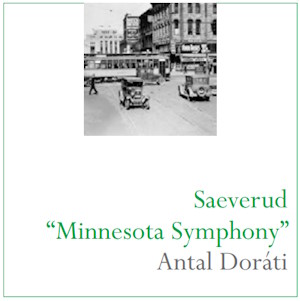
Harald Sæverud (1897-992)
Symphony No.8 ‘Minnesota’ (1958)
Ernst Toch (1887-1964)
Symphony No.2, Op.73 (1953)
Minneapolis Symphony/Antal Doráti
rec. live, 18 October 1958 (Sæverud), 12 November 1954 (Toch), Northrop Auditorium, Minneapolis, USA
Antal Doráti Society ADL320 [68]
This is another release from the extensive catalogue of studio and live recordings issued by the Antal Doráti Society.
Doráti conducted the première of Harald Sæverud’s Symphony No.8 ‘Minnesota’ in October 1958. The work had been commissioned to mark the centenary of the establishment of the state and is a bold, colourful four-movement statement cast in a traditional structure, heard here in thankfully very good sound for the time. It opens quietly but gathers momentum and intensity and is full of percussive snap and barely suppressed excitement – tonal but occasionally brusque. The slow movement, the superscription for which is ‘Hope and longing’, is a slow but inexorably generating one, quietly memorable in its own way and finely sustained. The Scherzo is a quirky pastoral waltz and much the shortest of the four movements, whilst the finale (‘Man and the machine’) offers a strikingly percussive summation, sinewy and mechanistic, that ends the symphony persuasively. There is some inter-movement rustling from the audience but otherwise they are quiet. For a much more recent recording of the symphony, it’s best to turn to Ole Kristian Ruud’s recording with the Stavanger Symphony on BIS, though there’s also a recording by Dmitri Kitajenko with the Bergen Philharmonic on Simax. Both are somewhat more expansive than this tautly driven première performance.
Ernst Toch’s Symphony No.2, composed in 1953, was premièred in Germany but Doráti was soon to bring it to Minneapolis towards the end of the following year. The sound here is rather less good than in the 1958 Sæverud, flat, one-dimensional mono which doesn’t really do Toch’s teeming instrumentation full justice. The opening movement is especially terse and tense punctuated by brass-led interjections and percussive drama. One senses the Minneapolis Symphony is not as fluently in control of Toch’s rhetoric as it was to be with Sæverud’s, but it manages to convey the rare moments of Viennese lyricism in the second movement rather well. Piercing winds shriek in the third movement lending an almost unhinged element to the symphony though its end, in a moment of chorale-like quiet, offers a reprieve. The finale once again revisits all kinds of vehemence and here Toch’s sonic landscape include pianos and a resumption of the winds’ blistering intensity not to mention the percussion with kettle drums blazing.
For a fuller and more textually clear look at this symphony you’d need to turn to a contemporary recording, of course, and that’s where Alun Francis and the Berlin Radio Symphony on cpo come in. Their recording of all Toch’s symphonies also adds context to this canon of works.
However, for those interested in Doráti’s promotion of new symphonic works in Minneapolis, this is a good disc. It couples two works written at about the same time, that share qualities of colour and percussive drive but differ in tonal (Sæverud) and acerbically atonal (Toch) elements.
Jonathan Woolf
Availability: send email to Doráti Society

















